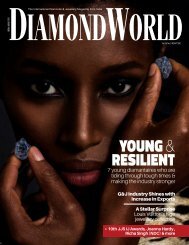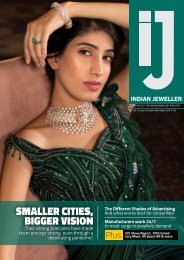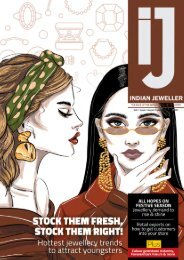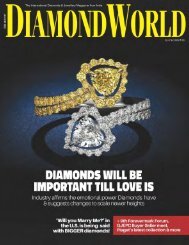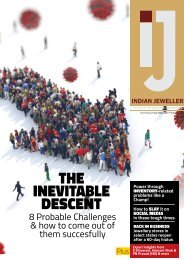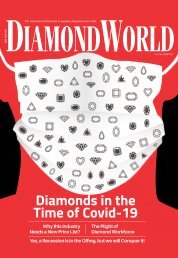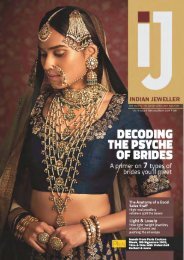Diamond World (DW) May - June 2020
Why Covid-19 will make people fall in love with diamonds all over again | Ban is good - Industry welcomes ban on rough imports | Hong Kong jewellery industry show mettle| An Irrevocable Loss - Arun R. Mehta, Rosy Blue Group
Why Covid-19 will make people fall in love with diamonds all over again | Ban is good - Industry welcomes ban on rough imports | Hong Kong jewellery industry show mettle| An Irrevocable Loss - Arun R. Mehta, Rosy Blue Group
You also want an ePaper? Increase the reach of your titles
YUMPU automatically turns print PDFs into web optimized ePapers that Google loves.
<strong>DW</strong> Promotion<br />
Source: Limelight Handcrafted <strong>Diamond</strong>s<br />
4. Increasing consumer acceptance for<br />
SUSTAINABLE PRODUCTS, especially post<br />
Covid-19<br />
This message has resonated strongly with consumers and the post-<br />
Covid era is likely to see a strong shift in the behaviour, attitudes and<br />
purchasing patterns of consumers. Several studies and analysis,<br />
including the recent Bain & Co report suggests that consumers in<br />
response to the crisis will have an increased environmental and<br />
social consciousness and sustainable alternatives to conventional<br />
products will start having a preference.<br />
CVD <strong>Diamond</strong>s are not just flawless but they do not bear<br />
the burden of mining and save 109 gallons of water and 1,750<br />
tonnes of earth per carat. Land mass and water being the most<br />
precious and stretched resources today.<br />
Even pre-Covid era, with the rising consciousness amongst<br />
consumers for saving the environment, several sustainable<br />
alternatives have emerged across industries such as electric<br />
vehicles, recycled fashion, bamboo brushes and straws etc.<br />
However, all these products are yet to scale and currently<br />
remain more expensive that their conventional counterpart for<br />
the end customer.<br />
Interestingly, the gems & jewellery industry is strongly<br />
placed with a sustainable product like the lab grown diamonds<br />
that are affordable relative to the natural diamonds.<br />
“Women in today’s age make their own choices and decisions.<br />
They have their own independence not just in terms of profession<br />
but are now more empowered in their thoughts and opinions. This<br />
is very much starting to reflect in the trends in the fashion and<br />
jewellery industry where more women are opting for sustainable<br />
options - such as the lab grown CVD diamonds - that allow them<br />
to enjoy several luxuries without damaging the planet for the<br />
future generation. With women getting economically and socially<br />
independent they deserve to celebrate every little achievement and<br />
any big success with a girl’s best friend - a sustainable diamond.” –<br />
Pooja Sheth, MD & Founder of Limelight Handcrafted <strong>Diamond</strong>s.<br />
5. Lab grown CVD diamonds are certified as<br />
the purest Type IIa diamonds<br />
CVD diamonds are classified as the purest type of diamonds<br />
– Type IIa – by world’s leading diamond certifying organisations<br />
such as the SGL labs & IGI.<br />
Type IIa diamonds are devoid of any impurities and almost<br />
entirely composed of carbon. As a result, the brilliance, shine<br />
& lustre of a Type IIa diamond is significantly better than any<br />
other type of diamond. Any such diamond even with a natural<br />
origin has a mention of Type IIa on its certificate and is sold at a<br />
5 – 15% premium in the market. But such diamonds are rare to<br />
find under the earth’s surface as 98% of natural diamonds have<br />
nitrogen impurities. Only 2% of all natural diamonds in the world<br />
have been classified as Type IIa.<br />
The world-famous Koh-i-Noor, 105.6-carat, is a Type IIa<br />
diamond, found from the ancient Golconda mines (now between<br />
Telangana and Andhra Pradesh). Some of the most world famous<br />
Type IIa diamonds have emerged from the Golconda Kullur<br />
mines in India.<br />
However, due to the rarity of Type IIa diamonds, most<br />
consumers do not have access to the purest diamonds. Through<br />
the CVD technology, and only through this technology, the Type<br />
IIa privilege can be brought at the hands of each consumer.<br />
In addition, lab grown diamonds particularly CVD diamonds<br />
have resale value. Brands like Limelight <strong>Diamond</strong>s, offer its<br />
consumers buyback and 100% exchange opportunities.<br />
“The beauty of technology is that it permits you to enjoy<br />
something you could never even dream of. Truly, an industry<br />
revolution, CVD diamonds turn dreams into reality by offering<br />
Type IIa diamonds that belong to the same league as the Koh-i-<br />
Noor at the hand of every consumer. At the same time creating a<br />
new kind of heritage that can protect the legacy of the diamond yet<br />
preserve the planet for a brighter future for all,” says Pooja Sheth.<br />
“India was ONCE one of the largest mines for Type IIa diamonds<br />
and India now ONCE AGAIN stands the chance to be the largest<br />
mine for Type IIa diamonds through the CVD technology.”<br />
Source:<br />
Limelight<br />
Handcrafted<br />
<strong>Diamond</strong><br />
Jewellery<br />
Disclaimer: This article is for advertorial purpose only. All information has been provided by Limelight Lab-Grown <strong>Diamond</strong>s Ltd.<br />
<strong>Diamond</strong> <strong>World</strong> will not be responsible for decisions based on this article.<br />
DiamonD WorlD | may-june <strong>2020</strong> | 107






